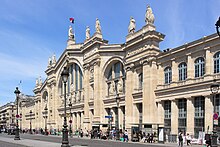Wikijunior:Transport/Infrastructure

Network engineering
[edit | edit source]
Among the types of infrastructure for transport are ancient road networks, canal networks, harbours and ports and in the modern era; railway networks, railway stations, freeway/motorway networks.
Rail
[edit | edit source]Urban rail systems are called metro systems such as London Underground (the tube) or New York City subway. Hybrid urban-suburban rail networks are called S-bahn systems.
Route engineering
[edit | edit source]
Bridges, tunnels and viaducts are ancient construction methods for navigating passage of transport to surmount natural impediments or otherwise improve the route. The longest bridges are in China.
Termini
[edit | edit source]
Termini or terminuses are the end of the journey or the end by a particular mode of transport. This includes railway stations, airports, helipads, parking lots, bus stops, bus depots, driveways, cable car station, ports, harbours and bicycle stands or bicycle parking. Intermodal or interchange stations offer transfer to other modes of transport typically bus stations and coach stations.